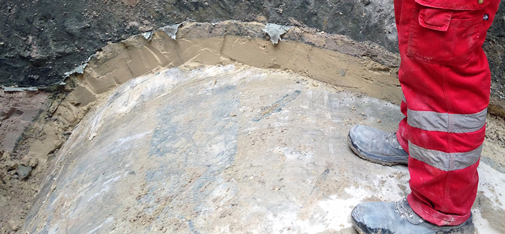-

New product
New cementless TBM backfill grout
Together with PORR Bau GmbH, MC has developed a new TBM backfill grout based on a geopolymer that is suitable for use in swelling rock formations.
New cementless TBM backfill grout
29-09-2020
Together with PORR Bau GmbH, MC has developed a new TBM backfill grout based on a geopolymer that is suitable for use in swelling rock formations. This cementless annular gap filler prevents swelling pressures, is sulphate-resistant and provides a permanent bedding for securing the tunnel tube.
In tunnel boring, segments known as tubbings are positioned to create the tunnel tube. The action of the tunnel boring machine is toleranced to create a clearance between the existing rock and the tubbings. In order to enable transmission of the drilling forces and reduce surface subsidence, this annular gap has to be completely filled with grouting materials in a process generally referred to as backfilling, with the materials used falling into one of two categories – singlecomponent (1C) and two-component (2C) grouts. The 1C grouts contain cement, additives, aggregates and water. Concrete admixtures are used to create specific application properties. 2C backfill grouts consist of cement, bentonite and water. Here stabilisers are used to provide for the necessary application properties while ensuring a working time of 48 to 72 hours. 2C grouts are suspensions made up with large amounts of surplus water, allowing them to be pumped over distances of several kilometres. They are thus comparatively easy to use. In Asia, 2C backfill grouts have been in use for many years. They were applied for the first time in Germany for the Emscher Project. And here too, MCBauchemie worked closely with PORR Bau as a key player in developing the required formulation. MC supplied all the necessary additives and provided the application engineering support.
Limits of conventional TBM backfill systems
Both methods – 1C and 2C – have their advantages, but cannot be used for boring swellable rock, e.g. that containing anhydrite, because both are cement-based and release excess water to the surrounding substrate. If anhydrite comes into contact with water, gypsum is produced as the reaction product. This reaction is accompanied by a volume increase of around 60 per cent. The associated swelling pressures are so enormous that elevations at the earth’s surface can occur and underground structures can be permanently damaged or even destroyed. When working in strata containing anhydrite, therefore, it is essential to prevent the release of surplus water from the grout to the surrounding rock. This is not possible with cement-bound materials.
A backfill grout suitable for anhydrite rock
MC-Bauchemie and PORR Bau have thus developed a completely new kind of annular gap filler based on a geopolymer. Geopolymers are inorganic binders that do not contain cement and whose structure can be traced back to aluminosilicates. The binder of the new backfill grout consists of granulated blast furnace slag and fly ash. Aggregates are used to stabilise the mix. An activator is added to the supply device via which the backfill grout is introduced into the annular space. This triggers the binder reaction. The grout also contains a variety of phosphates that suppress anhydrite swelling. The concrete-like properties of this TBM backfill grout enable production in a ready-mix concrete plant located at the construction site. The long processing time of the material gives tunnel builders more flexibility, as without addition of the activator the grout can be stored for long periods without deterioration. This novel grout material is currently being successfully used in the anhydritebearing unleached gypsum keuper of the “Stuttgart 21” project.
Your contact:
Saki M. Moysidis, PR-Manager

© MC-Bauchemie 2025
-
News
Click here to go to our News section.
-
Magazine
Get our latest issues of our customer and employee magazine MC aktiv.
-
Downloads
Find all relevant datasheets of our products as well as brochures of our company, Fields of Expertise and product categories here.
-
References
Click here to get to our library with reference projects for all types of application.
-
Careers
Click here to go to MC Career.
-
Contact
Click here to go to our Contact section.
